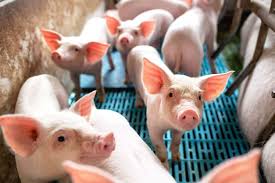Pigs are kept in one form or another almost everywhere in the world. In rural areas of many parts of the world, it is still common to find pigs rooting and roaming freely around communities.
Such pigs are sold or slaughtered as the need arises. Pig-keeping enterprises are also found in and around towns and cities, playing an important role in feeding the urban population.
Taxonomy (Biological Classification) of Pigs
Below is the taxonomy of the pig:
Kingdom – Animalia
Phylum – Chordata (Animals with backbones)
Class – Mammalia (Warm-blooded animals that suckle their young)
Order – Artiodactyla (Even-toed hoofed animals)
Family – Suidae (Non-ruminant or single stomach system)
Genus – Sus (Restricted wild European boars from which domestic pigs are bred)
Species – Sus scrofa and Sus vittatus
Read Also: Hydroponics Garden Complete Beginners Guide
Advantages of Pig Farming

1. High Prolificacy: Pigs are capable of producing large litters after a relatively short gestation period. They also have a short generation interval and grow fast.
2. High Meat Yield: The productivity of pigs in terms of meat yield per tonne of live weight of breeding females per year is six times that of cattle.
3. Flexible Marketing and Consumption: Their body size makes them more flexible for marketing and consumption compared to cattle.
4. Meat Processing Suitability: Pig meat is suitable for processing, and some processed products have a longer shelf life than fresh meat, making distribution easier.
5. Efficient Feed Conversion: Pigs convert feed to meat twice as efficiently as ruminants, making them highly efficient in feed utilization.
6. Quick Investment Turnover: Pig production provides a quicker return on investment compared to cattle farming.
7. Availability of Veterinary Care: Curative and preventive drugs are available for most swine diseases.
8. Useful By-products: Pig faeces serve as an excellent source of manure.
9. Wide Adaptability: Pigs can be reared almost anywhere with proper housing and management, though managing them in extreme temperatures can be expensive.
10. Environmentally Friendly Meat Production: Pigs produce meat without contributing to the deterioration of natural grazing land, which is crucial in preventing desertification, soil erosion, and land degradation in some tropical regions.
Disadvantages of Pig Farming

1. Cultural and Religious Restrictions: In regions where the Islamic religion prevails, there is a strong taboo against eating pig products, limiting the market for pork. Muslims and many Jewish sects forbid pork consumption.
2. Perception as an Unclean Animal: Historically, pigs have been considered unclean due to their wallowing behavior, making them an object of dislike and concern for human health.
3. Competition for Human Food: Pigs and birds have relatively short digestive tracts, requiring high-quality concentrate feeds such as staple grains and oilseeds, which are also used as human food, leading to direct competition with humans.
4. Environmental Pollution: Since pigs are often raised close to human settlements, their waste can become a pollution problem if not managed properly.
Read Also: The Health Benefits of Using Dukkah Seasoning on your Cooking
Common Terminologies in Pig Husbandry

1. Boar: Mature uncastrated male.
2. Barrow: Castrated male before puberty.
3. Hog: Castrated male.
4. Stag: Adult male castrated later in life.
5. Shoat: Swine of both sexes weighing 30-80kg.
6. Gilt: Young female swine before farrowing.
7. Sow: Adult or mature female after one or two pregnancies.
8. Barrener: Sterile female.
9. Farrow: Act of giving birth.
10. Herd: Group of swine.
11. Litter: Group of young piglets.
The production of pigs in the tropics contributes significantly to meeting the demand for animal protein. Pork is consumed by a large segment of the population, although religious restrictions limit its consumption in some areas.
Do you have any questions, suggestions, or contributions? If so, please feel free to use the comment box below to share your thoughts. We also encourage you to kindly share this information with others who might benefit from it. Since we can’t reach everyone at once, we truly appreciate your help in spreading the word. Thank you so much for your support and for sharing!
Frequently Asked Questions
We will update this section soon.

